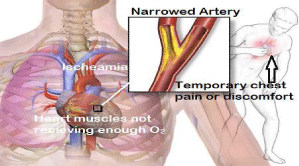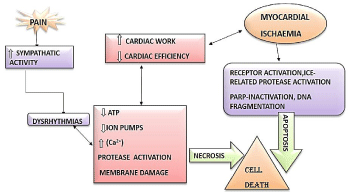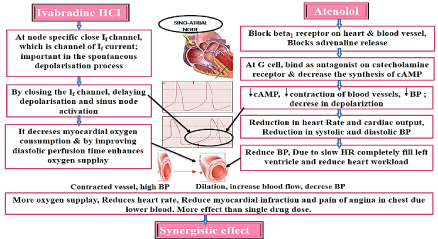
Review Article
Austin J Anal Pharm Chem. 2016; 3(1): 1059.
Combined Pharmacology of Ivabradine Hydrochloride & Atenolol useful in Chronic Stable Angina Pectoris
Patil PA¹*, Raj HA¹ and Sonara GB²
¹Department of Quality Assurance, Shree Dhanvantary Pharmacy College Kim, Surat, Gujarat
²Department of Quality Assurance, Gujarat Technological University, Ahmedabad, India
*Corresponding author: Patil Pooja A, Department of Quality Assurance, Shree Dhanvantary Pharmacy College, Kim, Gujarat, Gujarat Technological University, Ahmadabad, India
Received: February 07, 2016; Accepted: March 08, 2016; Published: March 09, 2016
Abstract
The main objective of this review article is to provide pharmacological information of combined therapy of Ivabradine Hydrochloride and Atenolol to researcher in development of combined dosage form for treatment of angina pectoris. It presents the pharmacology of combined Dose of drugs Ivabradine HCl and Atenolol which are treating Chronic Stable Angina Pectoris, Myocardial Infarction and Heart Failure. In modern clinical practice, many patients with stable angina pectoris require treatment with more than one anti-angina drug. In this combination of these 2 drugs show synergistic effect. The antianginal drug Ivabradine, specific If channel blocker responsible for depolarisation process and reduce myocardial oxygen consumption. Atenolol which is β1-blocker declines synthesis of cAMP (Cyclic adenosine monophosphate) which reduces BP (Blood Pressure) and delaying depolarisation process. According to clinical trials in 50mg Atenolol with 7.5 or 5mg Ivabradine taken in formulation, 4,954 patient of angina treated with for 4 months every day, from that 344 patient received treatment with Atenolol and other placebo only Ivabradine HCl. After 4 months that 344 patients show more beneficial effect than placebo and angina pectoris reduces from 2.8 ± 3.3 to 0.5 ± 1.3 bpm per week. So combination of both drugs show synergistic effect with no any unwanted causes or adverse drug effect.
Keywords: Ivabradine Hydrochloride; Atenolol; Chronic stable angina pectoris
Introduction
Angina Pectoris, Ischaemia, myocardial infarction and Various Heart Disease occurs due to Ischemic Heart disease (IHD) and Coronary Heart disease (CHD).
Angina pectoris
Angina pectoris (angered= to strangulate, pectus= chest) is the sensation of chest pain, pressure, or squeezing, often due to ischemia of the heart muscle from obstruction or spasm of the coronary arteries [1-3].
The angina pain occurs due to imbalance between the oxygen requirement and oxygen supply in the ischemic area of myocardium [4]. So O2 supply to myocardium is insufficient for its need (Figure 1).

Figure 1: Symptoms of Angina Pectoris.
Its pain distributed in chest, arm and neck is brought on by excretion, cold or excitement. Many times when this pain occur in muscles or skeletal because of muscles contracted and since blood flow interrupted [1]. Mainly 3 types of Angina pectoris: -
- Stable angina pectoris
- Unstable angina pectoris
- Variant angina pectoris
Myocardial infarction occurs due to coronary blocks by thrombus (Figure 2).

Figure 2: Myocardial Infarction.
Ivabradine HCl
Ivabradine is antianginal drug, its chemical formula is C27H36N2O5 · HCl with IUPAC name (S)-3-{3-[(3,4-dimethoxy bicycle [4.2.0]octa-1,3,5-triene-7-ylmethyl) Methyl amino] propyl}-7, 8-dimethoxy-2, 3, 4, 5-tetrahydro-1H-3-benzazepine-2-one. It is white off solid compound with molecular weight 505.05 gm/mole. [3-4] It shows absolute oral bio availability approx. 40% because of firstpass elimination [5] (Figure 3).

Figure 3: Structure of Ivabradine HCl.
Mechanism of action: The If current is important in the spontaneous depolarisation process. This agent inhibits the If channel and slows the heart rate. This action occurs by closing the If channels, thus delaying depolarisation and sinus node activation. It also reduces myocardial oxygen consumption & by improving diastolic perfusion time enhances oxygen in blood [6].
Atenolol
Atenolol [(RS)-4-(2-hydroxy-3-isopropyl amino propoxy) phenyl Acetamide] is Antihypertensive drug. It is white crystalline powder with molecular weight 266.34 gm/mole [5,7] (Figure 4).

Figure 4: Structure of Atenolol.
Mechanism of action: Atenolol is selective β1>>>β2 blocker, which is used in the treatment of hypertension, ischemic heart disease, congestive heart failure, and certain arrhythmias [8-10]. It shows 50 % oral absorptive in Gl track and metabolized by liver [11].
Combination Therapy of Ivabradine Hydrochloride and Atenolol
Ivabradine are capable of potentiating the effects of beta-blockers on increasing exercise capacity which is related to a synergy effects with no untoward effect on safety or ADR (Figure 5).

Figure 5: Mechanism of Ivabradine HCl with Atenolol.
Combination of Ivabradine HCl with Atenolol demonstrated efficacy superior to Ivabradine HCl alone. Combination treatment is safe and more effective.
In modern clinical practice, many patients with stable angina pectoris require treatment with more than one anti-angina drug; Ivabradine is a pure heart rate-lowering agent that acts by inhibiting If, an important ionic current involved in the pacemaker activity in cells of the sino-atrial node. Ivabradine reduces the slope of spontaneous diastolic depolarization in these cells and lowers heart rate at rest and during exercise. Ivabradine has demonstrated anti ischemic and antianginal efficacy in randomized trials in patients with chronic stable angina pectoris when compared with placebo and has been shown to be non-inferior to atenolol.
The literature and opinion leaders in the field of cardiovascular disorders generally conclude that it is difficult to demonstrate the superiority of associations comprising a β-blocker plus another class of anti-angina compounds over β-blocker monotherapy in the treatment of stable angina.
Based on patent
Sinus node If current inhibitors and more especially, Ivabradine are capable of potentiating the effects of β-blockers on increasing exercise capacity. This increasing of exercise capacity is related to a synergy between the active ingredients, i.e. in the pharmaceutical compositions according to the invention, the amounts of sinus node If current inhibitor and of β-blocker are matched to the nature of those active. Preferably, when the sinus node If current inhibitor is Ivabradine, the administration dose is from 5 to 7.5 mg twice per day (b.i.d.). When atenolol’s daily administration dose is preferably 50 mg in one administration [12] (Table 1).
INGREDIENT
QUANTITIY
USE
Ivabradine HCl
100 mg
Antianginal
Atenolol
1000 mg
Antihypertensive
Starch
120 mg
Binder
Magnesium Stearate
40 mg
Lubricant
MCC
1000 mg
Filler
Lactose
1732 mg
Diluent
Hydrophobic colloidal silica
8 mg
Anti-adherent Agent
Total
4000 mg (4 gm)
Table 1: Ingredients quantity use.
Based on clinical trial
The principal parameters measured in the course of the effort test are total exercise duration (TED) includes the time taken for the treadmill to come to a stop or, that is duration of about 10 seconds starting from the patient’s request to stop the exercise; the time until the “angina pectoris” pain forces the patient to stop the exercise (TLA); the time until the onset of the “angina pectoris” pain(TAO); the time taken for a 1 mm ST segment depression (TST) to appear on the electrocardiographic recording, this being a reaction of ischaemia and corresponding to the electrical sign of pain in the cardiac muscle [13-15] (Table 2).
β-blocker + Ivabradine (n=441)
β-blocker + placebo (n = 434)
P-value
TED
24 ± 65
8 ± 64
p < 0.001
TAO
49 ± 83
23 ± 79
p < 0.001
TLA
26 ± 66
9 ± 64
p < 0.001
TST
46 ± 93
15 ± 87
p < 0.001
Table 2: Clinical trial Data of Ivabradine + Atenolol in patient.
4,954 patient of angina treated with for 4 months every day, from that 344 patient received treatment with Atenolol and other placebo only Ivabradine HCl. After 4 months that 344 patients show more beneficial effect than placebo and angina pectoris reduces from 2.8 ± 3.3 to 0.5 ± 1.3 bpm per week [13].
This study shows that Ivabradine is capable of improving exercise tolerance in patients already receiving a standard dose of β-blockers.
From patent & Clinical Trials of combination it gives the dose ratio 1:10 to treat Myocardial ischemic heart failure.
Conclusion
From this combination therapy of Ivabradine HCl with Atenolol was found to be effective in treatment of Stable Angina pectoris, Myocardial infarction& heart disease. This review represents individual pharmacology of Ivabradine Hydrochloride and Atenolol combination useful in treatment of Stable Angina pectoris, Myocardial infarction & heart disease. This review will helpful for researcher in future studies and also for development of combined formulation of Ivabradine Hydrochloride and Atenolol as there no formulation is available.
References
- Walker R, Edwards C. Clinical pharmacy and Therapeutics. 3rd Edn, Mumbai: Elsevier Ltd. 2003; 281-285.
- Rang HP, Dale MM, Ratter JM. Rang and Dale’s Pharmacology. 6th Edn, Mumbai: Elsevier Ltd. 2007; 284, 286.
- Drug profile of Ivabradine HCl. [cited 2015 Sep 12].
- Drug profile of Ivabradine HCl. [cited 2015 Sep 16].
- Pharmacokinetic of Ivabradine HCl. [cited 2015 Sep 13].
- DiFrancesco D, Camm JA. Heart rate lowering by specific and selective I(f) current inhibition with ivabradine: a new therapeutic perspective in cardiovascular disease. Drugs. 2004; 64: 1757-1765.
- Drug profile of Atenolol. [cited 2015 Sep 14].
- Drug profile of Atenolol. [cited 2015 Sep 16].
- Drug profile of Atenolol. [cited 2015 Sep 17].
- Brunton LL, Parker KL. Goodman & Gilman’s Manual of Pharmacology and Therapeutics, 10thEdn; The McGraw-Hill Companies, New Delhi. 2008; 148, 159.
- Pharmacokinetic of Atenolol. [cited 2015 Sep 15].
- Guy Lerebours-Pegeonniere, Levallois-Perret, Jean-Henri Calvet. Drugs comprising combination of Sinus node if current channel blocker with ß-blocker. United States Patents US 8217030 B2, 2009.
- Koester R, Kaehler J, Ebelt H, Soeffker G, Werdan K, Meinertz T. Ivabradine in combination with beta-blocker therapy for the treatment of stable angina pectoris in every day clinical practice. Clin Res Cardiol. 2010; 99: 665-672.
- Tardif JC, Ponikowski P, Kahan Th. Efficacy of the If current inhibitor Ivabradine in patients with chronic stable angina receiving beta-blocker therapy: a 4-month, randomized, placebo-controlled trial. Eur. Heart. J 2009; 30: 540–558.
- Christensen LP, Zhang RL, Zheng W, Campanelli JJ, Dedkov EI, Weiss RM, et al. Postmyocardial infarction remodeling and coronary reserve: effects of ivabradine and beta blockade therapy. Am J Physiol Heart Circ Physiol. 2009; 297: H322-330.